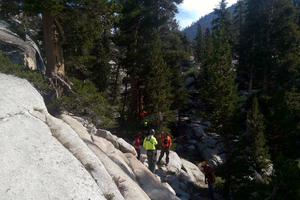Miyuki Harwood rescued after nine days in wilderness: How to pack for survival
Hiker Miyuki Harwood was found on Saturday by a search-and-rescue team after being lost in the Sierra Nevada for nine days.

This photo shows the area where Miyuki Harwood was found Saturday after she used a whistle to get the attention of a search-and-rescue team looking for her. Authorities say she survived by dragging herself to a creek and using a water filter to drink from it.
Fresno County Sheriff's Office/AP
Having a portable GPS tracker might have dramatically reduced the amount of time a lost day-hiker spent without aid, but all the gadgets in the world can’t substitute for experience apparel when you’re lost in the wilderness.
Folsom, Calif., hiker Miyuki Harwood was rescued after surviving for nine days with what she packed for a simple day hike in the Sierra National Forest. She was found injured, but alive, Saturday near the Courtright Reservoir near Fresno, according to USA Today.
Ms. Harwood, who is a systems analyst for computer chipmaker Intel, took some days off work to go hiking with a Sierra Club hiking group, but became separated from her companions.
“She had a pocket water filter and was dressed properly, but still, what she did was absolutely extraordinary for someone who packed to be part of a group, but ended up hiking alone,” says survivalist and wilderness living trainer Lucas Miller of Maui, Hawaii, in an interview. “I commend her. That’s a serious ordeal that she went through. To be honest, given what little she had with her I would have had a hard time making it through, with a broken leg, having to crawl to anywhere I needed to go. She’s amazing.”
Mr. Miller recently spent 39 days surviving in the wilderness with just a backpack full of basic survival gear and an axe for the show, “Alone,” on the History Channel.
“Everyone feels a day hike is a benign hike. It’s like it’s safe because it’s during the day and you’re not facing the dark of night – 'tra la la la la' – and then you get separated or turned around, before you know it, it’s night and cold, and it’s a whole different situation,” he says. “I can’t stress enough that your clothes are your first shelter. It looks like [Harwood] knew that and had that. Wear layers and always take a good insulated jacket and hat. Your clothing is where it’s at.”
The key to surviving a day hike gone wrong, Miller says, is to pack for every day trip into the wilderness like it could turn into an overnight situation.
While the survivalist isn’t suggesting that hikers pack like campers, hauling tents and bedrolls, he does have suggestions for what light items could help to save your life. He suggests buying or renting a Yellow Brick or SPOT GPS tracking device which can help rescuers find you if you become lost. He also recommends packing a jacket, hat, ultralight tarp, lighter, pocket water-purification device, 550 nylon paracord for making shelter, extra food, a flashlight or headlamp, and a fixed-blade knife that will stand up to more rigorous use than a folding knife.
Miller says the only drawback to survival GPS trackers is the devices' need for a clear view of the sky. “But looking at where [Harwood] was located it looks like the trees were sparse and she could have had a good chance for getting a signal there,” he adds.
He adds that the GPS devices could also have helped in the case back in early July, when three sisters – Megan, Erin, and Kelsi Andrews-Sharer – were found after a multi-day search-and-rescue mission.
The sisters started hiking in Teton National Park on June 30, 2015. Their plan was to return to their car on July 5th. But when the group failed to arrive, rescuers began combing through the Wyoming wilderness with a team of up to 70 to 80 people.
“The GPS trackers and phones, these are good options, but they don’t replace skills. They are fallbacks, not fool-proof. There’s no substitute for experience and having the right tools and clothing to survive," Miller cautions.

